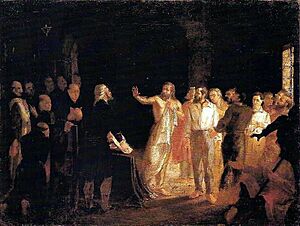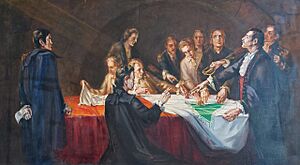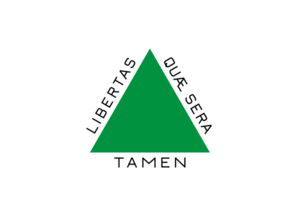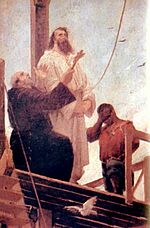Inconfidência Mineira facts for kids
The Inconfidência Mineira (pronounced een-kon-fee-DEN-see-ah mee-NAY-rah), also known as the "Minas Gerais Conspiracy," was a brave but unsuccessful attempt to make Brazil independent from Portugal. This happened in 1789, a long time ago, when Brazil was still a colony ruled by Portugal.
Many things led to this movement. One big reason was the success of the American Revolutionary War. The American colonies had just won their freedom from Britain, and this inspired many smart people in Brazil, especially in the region of Minas Gerais. They started thinking: "If America can be free, why can't we?"
Another major reason was about gold and taxes. Minas Gerais was famous for its gold mines. However, the gold was starting to run out. Even though there was less gold, the Portuguese government still demanded a lot of taxes, especially a tax of one-fifth of all gold found. When the miners couldn't pay enough gold, the government planned to collect an extra, very harsh tax called the derrama. This tax would force people to pay what they owed, even if it meant losing their homes or belongings. This made many people very angry.
The people who wanted independence, called "conspirators," planned to start their rebellion on the day the derrama tax was supposed to begin. However, their plans weren't very clear, and they didn't have one strong leader. Some wanted Brazil to become a republic (where people vote for their leaders), while others preferred a king. Some wanted to end slavery, but others thought it wasn't practical at that time. They did have some ideas for a new Brazil, like growing more cotton, using iron and saltpeter (a mineral) reserves, encouraging families to have more children, and creating a local army.
Many different kinds of people joined the conspiracy. There were soldiers, priests, and educated thinkers. Famous poets like Cláudio Manuel da Costa and Tomás Antônio Gonzaga were also involved. One of the most well-known participants was Tiradentes (whose real name was Joaquim José da Silva Xavier). He was a soldier and became the most enthusiastic person spreading the idea of independence.
Who Were the Conspirators?

The ideas behind the Inconfidência Mineira came from the Age of Enlightenment in Europe, which promoted freedom and new ways of thinking. The successful American Revolution also played a big part. Most of the conspirators were wealthy white people from Minas Gerais. Many had studied in Europe, especially at the University of Coimbra in Portugal.
A lot of these people owed money to the Portuguese government. With gold production going down, the government's plan to collect all these debts through the derrama was a main reason for the conspiracy. Many conspirators hoped to create a republic where leaders would be chosen by voting. They imagined their new capital city would be São João del Rei, and Ouro Preto would become a university town. However, they planned to keep the existing social structure, including the right to own property and slaves.
Unfortunately, three people involved in the movement told the government about the conspirators' plans. Because of this, the rebels were arrested in 1789. Among those arrested were the lawyer Alvarenga Peixoto, the poets Tomás Antônio Gonzaga and Cláudio Manuel da Costa, a priest named José da Silva de Oliveira Rolim, and the soldier Joaquim José da Silva Xavier, also known as "Tiradentes." After Joaquim Silvério dos Reis, one of the conspirators, informed on the group, Peixoto was captured and sent away to Portuguese Angola in Africa, where he lived the rest of his life.
What Happened Next?
The trials for the conspirators lasted from 1789 to 1792. Lieutenant Colonel Freire de Andrade, Tiradentes, José Álvares Maciel, and eight others were sentenced to death by hanging. Seven more were sent away forever to Africa, and the rest were found innocent.
However, Queen Maria I later changed the death sentences for most of them to being sent away forever. But this was not the case for Tiradentes. He bravely took full responsibility for the entire conspiracy. He was kept in prison in Rio de Janeiro and was hanged on April 21, 1792.
Today, the anniversary of Tiradentes' death, April 21, is a national holiday in Brazil. He is remembered as a hero who fought for Brazil's freedom.
In 1948, a movie called Minas Conspiracy was made about these events. In 1963, the state of Minas Gerais adopted the flag designed by the Inconfidência Mineira as its official state flag. It features a triangle, which the conspirators supposedly wanted to be green, but the state flag uses a red one. It also has a Latin motto from an ancient poem, meaning "Freedom, albeit late."
See also
- List of historical acts of tax resistance
- Vila Rica Revolt




